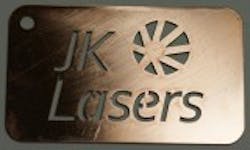Laser processing reflective materials
Rugby, UK -- Many products are manufactured from reflective materials. Electric car batteries contain copper, jewelry is commonly made from silver and gold, and even the 2012 Olympic torch is manufactured from aluminum.
Aluminum is a highly reflective material, redirecting around 92% of visible light and up to 98% of medium and far infrared radiation. This can make it difficult to process using lasers -- light from the laser is reflected back onto the delivery fibers, which can cause damage. Similar issues arise when processing other reflective materials including gold, silver, copper, brass, and certain polished metals.
To avoid reflected light, some manufacturers adjust the angle of the focus head. This alteration ensures reflected light is directed away from the laser, but at the expense of the spot shape. The resulting elliptical (rather than circular) spot can increase kerf and cut widths, creating imperfect designs.
JK Lasers has developed a patented system that directs reflected light away from the delivery fibers and into a beam dump without the need to adjust the focus head. Back reflection levels are continually monitored and trigger an automatic shutdown if acceptable limits are exceeded. Integrated into the company's Nd:YAG and fiber lasers as standard, back reflection protection also eliminates the need for a separate Faraday isolator. These are often costly and can cause power loss and beam degradation due to the thermal effects in the crystal.
Using this unique back reflection protection, a 500 W JK fiber laser can cut 1mm aluminum at 15 m/min (20 μm spot size). A similar kerf width is possible in 2 mm aluminum at 3.3 m/min.
For fine-feature gold and silver cutting, lower-power fiber lasers are ideal. For example, 0.7 mm gold can be cut with an 8 μm spot size at 0.2 m/min. Faster speeds are possible with higher-powered fiber lasers, but with correspondingly bigger kerf widths.
JK Lasers has a video of its aforementioned newly launched 2 kW fiber laser cutting copper. The design was cut at 4 m/min with short pulse widths to reduce the heat affected zone. Straight line cutting speeds of 10 m/min are achievable in reflective materials using the company's 2 kW fiber laser.
